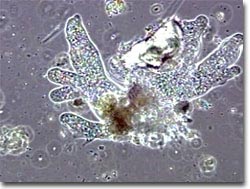
Case study: protoctista

Various kinds of directed movement, such as chemotaxis, thermotaxis (movement in response to heat), phototaxis and geotaxis (movement in response to gravity) are well-attested for protoctista (Martin and Gordon, 2001, p. 409). There does not seem to be any reason to treat these behaviours any differently from the directed movement of bacteria, as they do not appear to be flexible (see Conclusion F.3).
Case study: plants
The case of plants is philosophically interesting, because plants, unlike bacteria and protoctista, are incapable of locomotion: they stay where they are put. However, the possibility of cognition among plants should not be ruled out a priori. As Di Primio, Muller and Lengeler forcefully argue,
Plants can move in a variety of ways. Whereas a taxis is defined as a movement of a cell in response to a stimulus, a tropism is the directional growth of a plant organ in response to a stimulus such as light (phototropism), water (hydrotropism), touch (thigmotropism) or gravity (geotropism), while a nastic movement (nasty) is a movement of a plant organ in response to stimuli, that is independent of the direction of the stimuli (e.g. the opening of flowers in response to changes in temperature or light, or the folding up of the leaves of the Mimosa plant when touched) (Isaacs, Daintith and Martin, 1999).
While conceding that the movement of plants is "either reduced to the cellular level or rather slow", Di Primio, Muller and Lengeler compare it favourably to that of animals:
I would agree with the authors' contention that the possibility of mental states in the absence of locomotion deserves to be taken seriously. There is no a priori reason why the absence of locomotion in plants, fungi and certain animals should preclude the possibility of cognition on their part.
On the other hand, the presence of mental states needs to be properly argued for. Plant behaviour may well be very complex, as the authors allege, but complexity per se does not warrant the ascription of mental states (see Conclusion C.3). Unless the behaviour is flexible, we should adopt a mind-neutral intentional stance towards it (see Conclusion F.3). As far as I am aware, nothing in the literature to suggest that plant movement is flexible, according to the defintion used in this thesis, and as we have seen, research to date suggests that they are incapable of flexible (associative) learning.

...[T]he fundamental thing [for an organism to behave] is not the ability to move to a new location, but the ability to modify itself (by developing effectors as needed), i.e. to respond appropriately to changing conditions (2000, p. 10).
Their abilities to perform undirected (so-called nasties) and directed movements (taxes, tropisms), however, is almost as complex and diverse, and certainly as purposeful, as those of animals. Plants have to solve the same problems as other organisms (2000, p. 10).